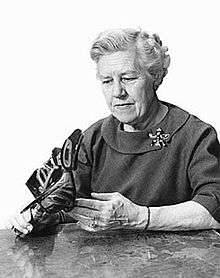Erna Gunther

Erna Gunther (1896–1982)[1] was an American anthropologist who taught for many years at the University of Washington in Seattle.
Gunther's work on ethnobotany is still extensively consulted today.[2]
Biography
Gunther graduated in 1919 as a student of Franz Boas, and received her MA in anthropology from Columbia University in 1920, studying under famed anthropologist Franz Boas. After graduating she moved with her husband, Leslie Spier, to the University of Washington in 1921. After leaving for a short period of time with her husband she returned in 1929.[3] When her husband left in 1930 she stayed at the University; at that time the marriage dissolved.
She formed part of the core of the newly formed anthropology program at the University of Washington in the 1920s, along with Spier and Melville Jacobs. In 1930 the Washington State Museum named her Director. The faculty grew from two residents in 1930 to ten in 1955 during her time as the University’s Anthropology Department. In 1966 she moved to the University of Alaska Fairbanks, becoming chair in 1967.
An American Indian specialist, her research focused on the Salish and Makah peoples of western Washington State, with publications on ethnobotany, ethnohistory, and general ethnology.
Her students included anthropologists Wayne Suttles, Dale Croes and Wilson Duff.
In 1949 she helped finance the archaeological investigation run by Charles E. Borden at Walen's farm (DfRs-3) on Boundary Bay.
Works
- An Analysis of the First Salmon Ceremony, American Anthropologist, Vol 28 (1926)
- Ethnobotany of Western Washington: the Knowledge and Use of Indigenous Plants by Native Americans, University of Washington Press, Seattle (1973)
Bibliography
- Abbott, Donald N. (ed.) The World Is as Sharp as a Knife: An Anthology in Honour of Wilson Duff. Victoria: British Columbia Provincial Museum.
- Miller, Jay, and Carol M. Eastman (eds.) (1984) The Tsimshian and Their Neighbors of the North Pacific Coast. Seattle: University of Washington Press.
- Garfield, Viola E. and Pamela T. Amoss (1984) 'Erna Gunther (1896–1982)'. American Anthropologist 86(2):394-399.
References
- ↑ Erna Gunther and the Ethnography of Western Washington
- ↑ "Her work is a foundation on which all subsequent ethnobotanical research in the area has been based; the book has been reprinted many times and was re-issued in 1973 with additional material." University of Washington Professor Viola E. Garfield and Pamela Amoss, in a 1984 biography of Gunther. See Ethnobotany of Western Washington
- ↑ E-Museum@Minnesota State University, Mankato, Biography of Erna Gunther Archived April 30, 2008, at the Wayback Machine.
- Biographical Note, Guide to the Erna Gunther papers, University of Washington Libraries, Seattle